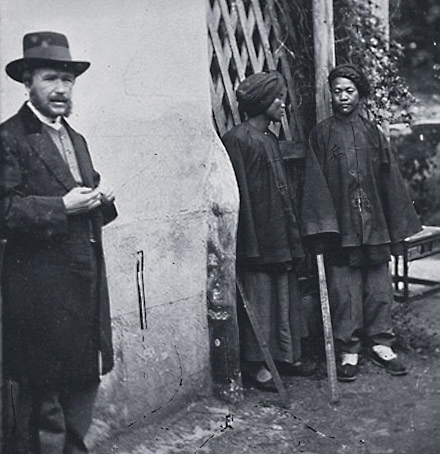 |
| |
Wellcome Library, London
John Thomson, born in Edinburgh, was the first Western photographer to travel widely through the length and breadth of China. This unit introduces his celebrated Illustrations of China and Its People: A Series of Two Hundred Photographs, with Letterpress Descriptive of the Places and People Represented, published in four volumes during 1873 and 1874.
Illustrations of China and Its People comprises the most extensive photographic survey of 19th-century China. Its scenic views illustrate the many places Thomson visited between 1868 and 1872. Its portraits and street scenes document the costumes, customs, and occupations of the people he encountered. Thomson provided extensive captions explaining the scenes and subjects he photographed.
John Thomson's China lll reproduces Thomson’s pioneer albums in full, along with an image gallery of all 200 photographs. John Thomson's China ll treats the images topically in a series of “visual narratives.” John Thomson's China l analyzes the scenic views and human “types” in Illustrations of China and Its People, and looks beneath Thomson’s elaborate travel narrative to expose the presumptions and prejudices that informed 19th-century Euro-American attitudes toward China and its people.
|
|
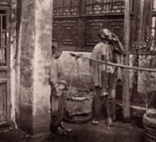 |
The photographs and captions by John Thomson
in this unit were generously provided by the
Beinecke Library at Yale University.
|
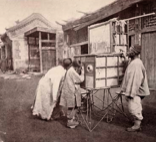 |
 |
| |
AN IMAGINED TRAVELOGUE
By any measure, John Thomson’s Illustrations of China and Its People was a remarkable achievement. Its 200 photographs comprise the most extensive single visual survey of mid-19th-century China. The captions accompanying each photograph combine detailed descriptions of the images with learned opinions from contemporary scholars and Thomson’s personal anecdotes. Written in an engaging style, these narratives enliven the images while situating them in their historical and cultural contexts.
|
|
| |
John Thomson’s Illustrations of China and Its People
Volumes 1 and 2, published 1873
Volumes 3 and 4, published 1874
|
|
| |
Thomson acquired his photographs between 1868 and 1872 during a four-year residency in Hong Kong, from where he made several tours of various regions of China. His travels, far more extensive than those undertaken by most Westerners of his generation, extended beyond the relative comfort and safety of the coastal treaty ports, most of which were established less than a decade earlier upon the conclusion of the Second Opium War. In some captions, Thomson draws attention to both the novelty of his undertaking and his adventurous spirit by describing the hostile reception he received in more remote regions of the country.
|
|
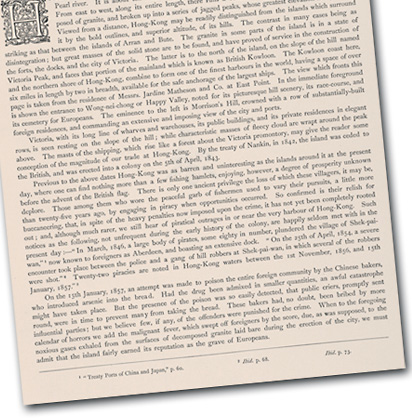 |
 Upon return to England, Thomson prepared his photographs of China for publication and wrote the lengthy accompanying text. Upon return to England, Thomson prepared his photographs of China for publication and wrote the lengthy accompanying text.
“Hong-Kong”
plate II, volume 1
ct1013-1014 (caption)
ct1015 (photo)
|
| |
Thomson organized his photographs and authored the lengthy captions for Illustrations of China and Its People after his return to Britain in 1872. The first two volumes were published in 1873; volumes three and four followed in 1874. The albums received much critical acclaim, as the following excerpt from a review in the November 11, 1874 edition of the Pall Mall Gazette indicates:
[Thomson] has secured a full record of all that is most interesting for us to learn concerning the ways of a remote civilisation, and he has even succeeded in registering types of the different classes of the population, from the highest to the lowest…. No picture of Chinese manners at once so full and so vivid has yet been attempted.... There is scarcely any side of Chinese life, either public or domestic, of which he has not secured some record.
While correctly emphasizing the significance of Thomson’s achievement, the reviewer’s enthusiasm and hyperbole also illustrate how little the West really knew of China at the time. In truth, Thomson’s pioneer publication barely scratched the surface of what was not only one of the world’s largest and most populated countries, but also one of its most isolated and least understood.
|
|
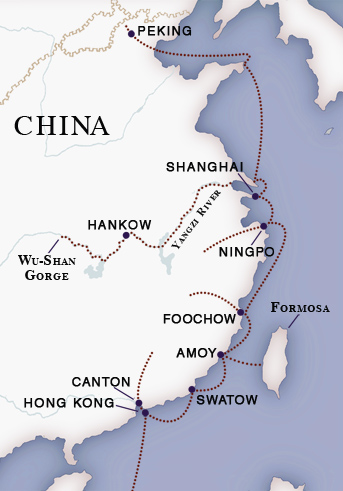 |
  This map traces Thomson’s route through China, as presented in the four albums. In reality it was not a continuous journey. This map traces Thomson’s route through China, as presented in the four albums. In reality it was not a continuous journey.
|
| |
The favorable reception accorded Illustrations of China and Its People suggests that Thomson possessed an acute sense of his projected audience and its desire to know more of China and the customs of its people. He honed these instincts operating a commercial photography studio that served Hong Kong’s growing population of foreign residents and tourists. As with most commercial photographers in Asia, Thomson worked in a wide variety of genres ranging from cartes de visite to portraiture and even government commissions. He was the official photographer for the Duke of Edinburgh’s 1869 visit to Hong Kong. Illustrations of China and Its People includes a photograph from this commission.
|
|
| |
“In this view, taken when H. R. H. the Duke of Edinburgh visited Hong-Kong, in 1869, H. M. S. ‘Galatea’ is seen at anchor off Peddlar’s Wharf.” (from caption)
“Hong-Kong Harbour,” plate III, volume 1 (detail)
ct1016 (caption) ct1017 (photo)
|
|
| |
Thomson’s photographs fall into two broad categories: scenic views and types. Views encompassed both natural landscapes and built environments. They could be panoramic, taking in large swaths of scenery, or they might highlight specific natural phenomena or individual structures.
|
|
| |
An example of a built environment in Thomson’s China:
“The clock-tower, designed by Mr. Rawlings in 1861, is a great ornament to the city, the clock too, when regulated properly, is of no inconsiderable service.” (from caption)
“The Clock Tower, Hong-Kong,” plate IV, volume 1 (detail)
ct1025 (caption) ct1026 (photo)
|
|
| |
Thomson’s “types” focused on the manners and customs of Chinese people and tended to highlight the defining features of gender, age, class, ethnicity, and occupation.
|
|
| |
Thomson mounted these four portraits of “types” on one page, with a detailed accompanying description:
“Of the four heads shown in these pictures, the two upper ones are fair types of the aged labourers of China. Darby and Joan have for many years been associated together, and their life has been a uniform scene of hardships and toil….The two lower heads are those of a son and daughter belonging to the same class.” (from caption)
“Four Heads, Types of the Labouring Class,” plate XI, volume 1 (detail)
ct1053 (caption) ct1054 (photo)
|
|
| |
Thomson sold individual photographs in various sizes and formats, as well as albums focused on specific themes. He also provided images for The China Magazine, the earliest photographically illustrated publication on China. The treaty ports of China proved to be an especially tough market for commercial photographers, with studios failing or sold to new proprietors willing to accept the risks. The four-year longevity of Thomson’s enterprise attests to his aesthetic vision, his technical mastery of the medium (he later published treatises on photography), and his business acumen.
In the introduction to Illustrations of China and Its People, Thomson states that he “endeavoured to arrange these notes [i.e., his captions] and illustrations as far as possible in the natural order or sequence of my journeys, which extended over a distance, estimated roughly, of between 4000 and 5000 miles.” He then describes the distribution of his itinerary across the four volumes:Volume 1: Hong Kong, Canton, Macao
Volume 2: Formosa (Taiwan), Swatow (Shandao), Chao-chow-fu (Chaozhou fu), Amoy (Xiamen), Foochow (Fuzhou)
Volume 3: Ningpo (Ningbo), Shanghai, Nanking (Nanjing), Kiu-kiang (Jiujiang), Hankow (Hankou), Yangtsze (Yangzi) River Journey
Volume 4: Peking (Beijing), Ming Tombs, The Great Wall
|
|
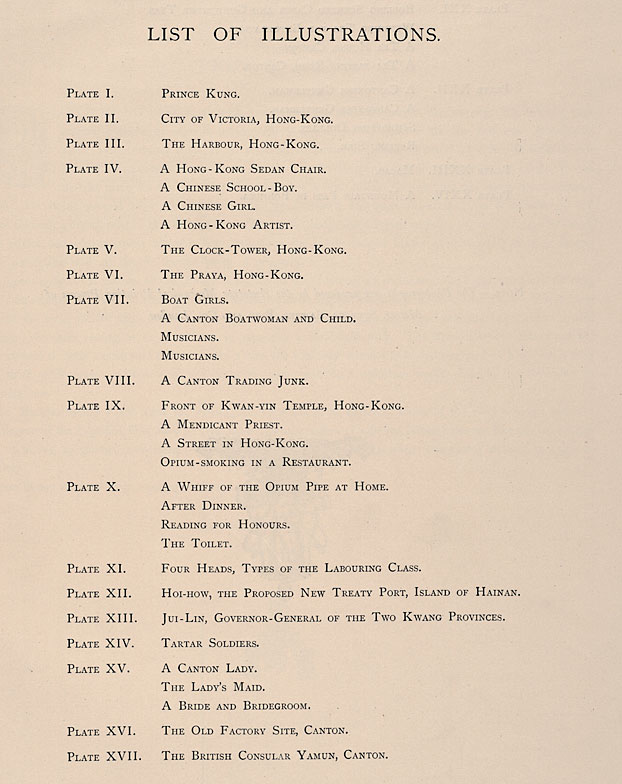 |
| |
Each volume begins with a table of contents that replicates Thomson’s itinerary and lists the photographs he produced in each locale.
“List of Illustrations,” volume 1 (detail)
ct1009-ct1010
|
|
| |
Technique & Aesthetics
Thomson arranged his photographs to enhance the sense of travel he hoped to convey. He introduces each of the locations he visited with a selection of representative scenic views. The types that follow are, for the most part, specific to the places or regions defined by the views. Thomson deployed these combinations of scenic views and types to highlight the unique character and sensibilities of each locale he visited. His captions often further reinforce the experience of travel by narrating movement from place to place. Viewing the four volumes sequentially, as Thomson intended, leaves readers with the feeling that they are accompanying him on a single continuous journey.
But the desire to travel with Thomson—the urge to turn the page, to move on to the next stop in the itinerary—is driven as much by Thomson’s impeccable technique and aesthetic vision as by the narrative structure of Illustrations of China and Its People. Drawing on conventions of the picturesque, Thomson composes and crops his images to maximize their visual and narrative impact.
For example, Canton, the second stop on his tour, lies inland and up river from Hong Kong. Thomson facilitates this transition in his narrative with an evocative image of a Canton junk. He opts for a horizontal format with the craft positioned on the extreme left in order to suggest movement along the river. His composition opens up a spectacular vista of the waterway linking Canton to Hong Kong. For emphasis, Thomson included two figures on near bank of the river looking out over precisely the same scene he offers viewers of the photograph.
|
|
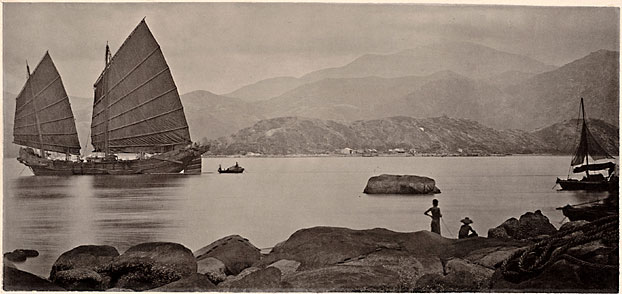 |
| |
“The term junk, applied by Europeans to all Chinese craft, whether trading vessels or ships of war, is probably derived from “jung,” the Javanese word for a large boat or vessel. Chinese ships vary in dimensions, model, and appearance, in the different parts of the Empire as much as do the sailing craft of Europe.” (from caption)
“A Canton Junk,” plate VIII, volume 1
ct1036-ct1037 (caption) ct1038 (photo)
|
|
| |
Thomson employs a vertical composition for his view of a Canton street to emphasize the urban density of a Chinese community. The street is cramped, the signs are unreadable, and local inhabitants interrupt their coming and going to glare back at the viewer. And yet despite the claustrophobic and perhaps threatening sensibility conveyed by this photograph, Thomson positioned his camera to capture the slight curve of the street in order to encourage the viewer’s curiosity. Just as his image of the junk invites us to follow him further upriver, this photograph stokes our desire to enter this environment and round the corner with Thomson as our guide.
|
|
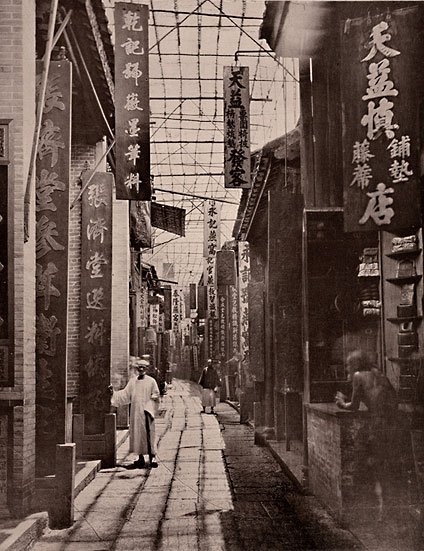 |
  “The streets of a Chinese city differ greatly from those of Europe, and are always extremely narrow, except at Nankin and Peking. They are paved crosswise with slabs of stone, usually worn down by the traffic to a hollow in the centre of the path, and this disagreeable substitute for the gutters of European throughfares forms the only means by which the rain-water is carried off.” (from caption) “The streets of a Chinese city differ greatly from those of Europe, and are always extremely narrow, except at Nankin and Peking. They are paved crosswise with slabs of stone, usually worn down by the traffic to a hollow in the centre of the path, and this disagreeable substitute for the gutters of European throughfares forms the only means by which the rain-water is carried off.” (from caption)
“Physic Street, Canton” plate XX, volume 1
ct1088 (photo)
ct1086-1087 (caption) |
| |
Thomson’s photograph of Golden Island near the mouth of the Yangze River demonstrates his familiarity with a more conventional approach to composition. The oval frame he employs to crop this image contains what would have been an expansive vista and focuses our attention on Thomson’s primary subject. More importantly, the oval frame offers Thomson a geometric shape within which he can align his image. The level ground plane leading the viewer’s eye to the island cuts across the oval with a strong horizontal axis. The pagoda rising from the left side of the island provides its vertical counterpart. But both axes are slightly off center; neither bisects the oval frame at its horizontal or vertical midpoints (and to do so would have resulted in a symmetrical but boring composition).
Thomson’s composition betrays his influences. In framing and aligning this image, he has appropriated a formula commonly used by 19th-century British landscape painters to draw viewers’ attention to the primary subjects of their paintings. In this photograph, our eyes are drawn to the architectural details of the temple, especially the rooflines highlighted by the sunlight. Given his distance from the subject, the remarkable detail Thomson captures in this image provides a particularly strong endorsement of his technical skills.
|
|
 |
| |
“Kin-shan, or Golden Island, has attractions of its own no less remarkable than those of the sister islet below Chin-kiang. It is, however, an island no longer, for the alluvial deposits of the Yangtsze’s floods have joined it so completely to the right bank of the river, that I had no difficulty in finding room on dry-land for taking the photograph here numbered 17.” (from caption)
“Golden Island, River Yangtsze,” plate IX, number 17, volume 3
ct3041 (caption) ct3042 (photo)
|
|
| |
Thomson’s types include a wide array of formats ranging from cameos, to half- and full-length portraits, to images of Chinese in situ such as the example shown here. In these photographs, Thomson offers viewers an example of upper-class domestic architecture, but the family occupying this house is of equal interest. The patriarch and his eldest son appear on the lower level of the dwelling while wives, concubines, children, and female servants gather on the upper balcony.
|
|
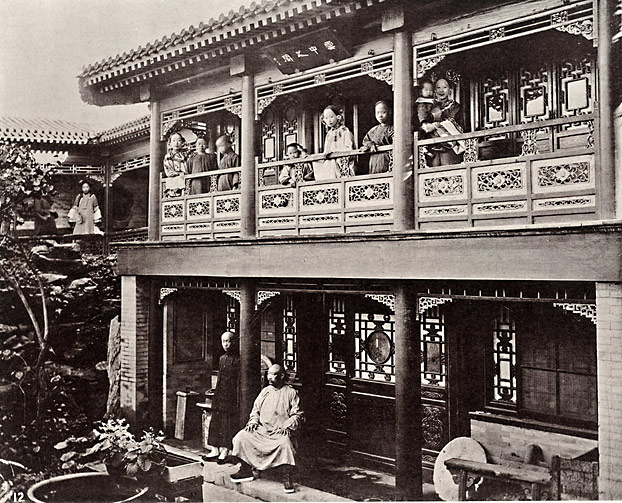 |
| |
“No exhaustive or thoroughly satisfactory description of the domestic architecture of the Chinese house has, so far as I am aware, ever yet been given. A principal reason for this omission is the lack of anything like complete acquaintance with the subject. The fact is, the country is in itself a vast one, and its domestic architecture, though remarkably similar throughout, yet presents wide divergences of construction, designed to meet the varying requirements of climate and position.” (from caption)
“Chinese House,” plate VII, number 12, volume 4 (detail)
ct4033-ct4034 (caption) ct4036 (photo)
|
|
| |
The “Chinese House” photograph offers a range of photographic types whose costumes and coiffures demarcate differences in age, gender, and social status. Thomson piques our interest in these matters with this image, then satisfies our curiosity with full-length portraits affording closer scrutiny of these or similar types.
|
|
  “The Manchu or Tartar lady may, on the whole, be said to approach more nearly than her Chinese sister to our Western notions of female beauty and grace. The former enjoys greater freedom, and her feet, which are never compressed, appear to be naturally small and well-formed.” (from caption) “The Manchu or Tartar lady may, on the whole, be said to approach more nearly than her Chinese sister to our Western notions of female beauty and grace. The former enjoys greater freedom, and her feet, which are never compressed, appear to be naturally small and well-formed.” (from caption)
“Manchu Toilet”
plate XIII, number 35,
volume 4
ct4065-4066 (caption)
ct4071 (photo) |
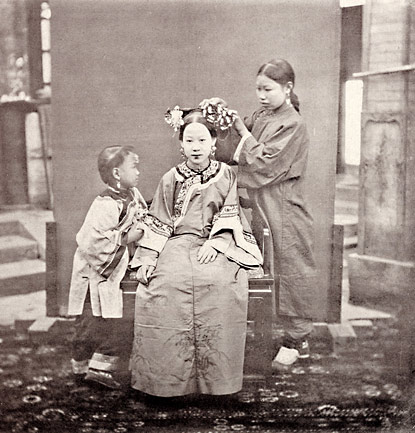 |
| |
As we follow Thomson’s itinerary and succumb to his narrative of travel, each image we encounter invites, tempts, cajoles, and demands our attention. Every photograph in Illustrations of China and Its People, be it scenic view or type, is visually seductive. They leave us wanting more, so we turn the page and continue our travels with Thomson.
|
|
| |
Thomson’s Many Chinas
Thomson’s four volumes were distinguished by their breadth and variety. He traveled widely, visited rural as well as urban areas, turned his lens on both the old and new, and offered portraits of a range of Chinese of different ethnicities and social classes.
|
|
| |
These images are details; click on them to view the complete images.
|
|
| |
Thomson’s decision to organize and caption his photographs as a travel narrative was in many respects yet another example of his well-honed business instincts. The treaties ending the Opium Wars opened China to the West, and with the establishment of several treaty ports, Westerners quickly acquired an avid interest in visiting China.
Real accessibility came with the regularizing of trans-Pacific passenger service in 1867 and the completion of the Suez Canal in 1869. With Thomas Cook initiating the globetrotter era of safe affordable travel upon completion of his first round-the-world tour in 1873, the treaty ports of China emerged as popular stopovers for tourists just as Illustrations of China and Its People was being published.
“Objectivity” in an Age of Imperialism
It is tempting, therefore, to characterize Illustrations of China and Its People as the coup de grâce of Thomson’s business ventures. But while his reputation and finances stood to gain, and while such concerns surely figured in Thomson’s calculations, his introduction to Illustrations of China and Its People suggests broader motivations for his project.
My design in the accompanying work is to present a series of pictures of China and its people, such as shall convey an accurate impression of the country I traversed as well was of the arts, usages, and manners which prevail in different provinces of the Empire. With this intention I made the camera the constant companion of my wanderings, and to it I am indebted for the faithful reproduction of the scenes I visited, and of the types of race with which I came into contact.… I feel somewhat sanguine about the success of the undertaking, and I hope to see the process which I have thus applied adopted by other travellers; for the faithfulness of such pictures affords the nearest approach that can be made towards placing the reader actually before the scene which is represented. The letter-press which accompanies the pictures, and which will render them, as I trust, more interesting and more intelligible, is compiled from information derived from the most trustworthy sources, as well as from notes made either by me at the time the subjects were taken, or gathered during a residence of nearly five years in China.
The earnestness of this declaration of intent is obvious. In both his images and captions, Thomson is aiming for comprehensiveness and truthfulness. He believes firmly in the power of photography to accurately document place and race. And we see a methodology in the making when he encourages other travelers to adopt his practices and protocols. Thomson’s claims, hopes, and advocacy make Illustrations of China and Its People very much a product of its time, when Britain in particular was engaged in consolidating a far-flung empire on which, as the saying went, the sun never set. His faith in the ability of photography to accurately represent foreign places and indigenous peoples was typical, and so too was his presumption of objectivity.
Today, well over a century later, we bring a more critical perspective to such claims about “trustworthy” information and “faithful reproduction.” Thomson’s opus opens a window not merely on “China,” but also on the uses of early photography and the broader milieu of 19th-century imperialist travel narratives. His curiosity and adventurousness are undeniable, and the intrinsic attraction of his photographs remains strong. At the same time, however, this celebrated publication also tells us a great deal about some of the assumptions and prejudices that Thomson and his enthusiastic Western audience shared concerning not just China, but foreign peoples and places more generally.
Illustrations of China and Its People provides a particularly useful case study to unravel the complex symbiosis between photography and 19th-century British imperialism. Thomson first arrived in Asia in 1862. Using Singapore as base of operations, he explored and photographed sites in Ceylon (now Sri Lanka), South India, Cambodia, Siam (now Thailand), and Indochina (now Vietnam). 1 Before establishing his studio in Hong Kong in 1868, he returned to England for a brief visit during which he became a member of both the Ethnological Society of London and the Royal Geographic Society. His associations with these learned societies predetermined to some extent the methodologies he developed and concerns he expressed in Illustrations of China and Its People.
Thomson’s engagement with learned societies deepened further after his return from China in 1872. Using his photographs, he presented the results of his China explorations to the British Association for the Advancement of Science in 1874. In 1886 he accepted the post of official instructor in photography with the Royal Geographical Society, which published his essay “Photography and Exploration” in the 1891 Proceedings of the Royal Geographical Society. Although Thomson framed Illustrations of China and Its People as a travel narrative, his affiliations with these institutions suggest that his photographic practices and his sojourns through various regions of China were motivated by far more than mere pursuit of the quaint, the picturesque, and the spectacular.
This essay extracts Thomson’s deeper agendas from his travel narrative and situates his images and photographic practices among the prevailing concerns of Britain’s 19th-century learned societies. Some of this territory has been already been addressed by James P. Ryan and Anne Maxwell, whose broadly conceived studies of colonial photography include discussions of narrow selections of Thomson’s photographs. My intention is to build on their scholarship by considering a wider array of images in a more detailed and comprehensive study of Illustrations of China and Its People. 2
To understand these agendas, it is necessary to examine smaller segments of Thomson’s travel narrative. He and the many travelers who followed in his footsteps used the treaty ports as bases of operation for their travels. These ports provided havens of Western civilization and culture. Thus chapter two—“Treaty Port Imagery”—focuses on photographs and descriptions of these places. Comparisons with his photographs of Chinese cites reveal Thomson’s attitudes toward the presence of Westerners in China.
Chapter Three—“Ethnology and Exploration”—examines two segments of Thomson’s travelogue that best illustrate his appropriation of the practices, attitudes, and values promoted by British learned societies: his visit to Formosa (now Taiwan) where he photographed the Pepohoan, a native tribe inhabiting mountainous regions of the island, and his 1200-mile journey up the Yangzi River. The Pepohoan had friendly relations and commercial interactions with Chinese living on Formosa, but their language and culture remained distinct. As photographic subjects, they thus provided Thomson with an opportunity to deploy practices advocated by the Ethnological Society of London. His photographs and narrative of the Yangzi River undertaking exhibit several hallmarks of expeditions supported by the Royal Geographical Society.
The two case studies examined in chapter three provide an analytical framework for chapter four: “Chinese ‘Types’”. Despite Thomson’s attempts to systematically document the people of China using the methodologies promoted by Britain’s learned societies, his taxonomy was riddled with inconsistencies and bias that favored colonial interests. Using a wide array of images, this section assesses the integrity and viability of the system Thomson developed for classifying, organizing, and presenting his photographs of Chinese people.
Chapter five—“Reframing the Past”—returns to Thomson’s scenic views with an examination of his photographs of China’s historic architectural monuments. These subjects were of tremendous interest to Westerners and an integral component of Thomson’s travelogue. The discussion accompanying these images focuses on the imperialist implications of Thomson’s photographic practices and aesthetic sensibilities.
|
|
| |

|
|
|





